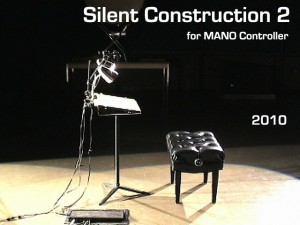The MANO Controller consists of a black rectangular surface, which is sensed with a video camera. The computer algorithm analyzes the image obtained from the video camera, looking for hands and extracting from them the most relevant parameters, which are then used to control sound.
ESP ///
El MANO Controlador consiste de una superficie rectangular negra que es capturada cenitalmente por una cámara de video de alta resolución. La computadora/ordenador analiza la imagen en búsqueda de formas que puedan ser manos, extrayendo de éstas los parámetros más relevantes que luego son usados para la generación de sonidos.
*************************************************************************************************************************************
One of the most interesting features of the MANO Controller is that it recognizes from which side a hand is entering the rectangle and is able to classify it as a finger or as a hand and to interpolate between them. Any gesture then is classified in terms of the side where it originates (left, right, bottom) and in terms of its size (as a finger or a hand).
Since a different mapping can be assigned to each combination of side and size (eg. left-finger or bottom-hand) at any given moment there can be 6 different sound mappings. Furthermore, combinations of these (eg. left-finger AND bottom-hand) might lead to a new mapping altogether. The use of these classifications of side and size allow the composer to use them combinatorially, controlling the movement through the score. This allows the performer to change and interpolate between mappings through continuous gestures without the need of using buttons.
For each hand or finger, multiple parameters are obtained. Most parameters are interdependent, that is, if one parameter changes it usually changes another parameter as well. This is an important feature since it allows for organic behavior of sounds.


Pingback: Miller Puckette: The Man Behind the Max and Pd Languages (and a Lot of Crazy Music) | obiKuo
Pingback: Miller Puckette: The Man Behind the Max and Pd Languages (and a Lot of Crazy Music)
Pingback: Miller Puckette: The Man Behind the Max and Pd Languages (and a Lot of Crazy Music) | IEEE Fort Huachuca